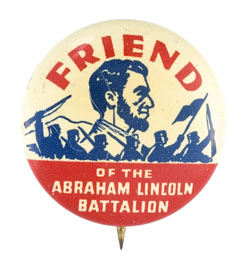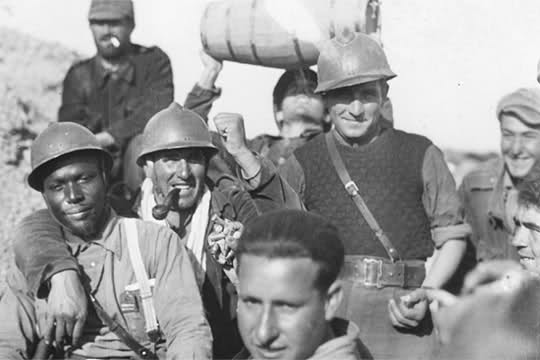
However, while disturbing and dangerous indeed, the good news is that ISIS members are not the only ones fighting not to mention there's plenty of ISIS recruits who aren't exactly crack troops (discretion advised). Right from the start of the new conflict in the Middle East, volunteers in the hundreds from all across the world have gone to take the fight against ISIS. Although the initial report was from a year ago, it states 300 fighters from 26 countries, almost entirely from the West, have joined anti-ISIS forces. There are well over a hundred Americans there. The volunteers have diverse backgrounds, have different motivations for fighting, and have extraordinary experiences.
Many are Iraq war veterans, returning to finish the work they started almost fifteen years ago, or have found they can't return to civilian life. Some are anarchists, hoping to kick out ISIS and build their own stateless society. All to at least some degree seem motivated to protect Christians and other civilians in the area, especially women, and fight evil. To me one of the most interesting stories is Kevin 'Christian' Howard's. A former soldier who served in Iraq, he befriended many people in minority ethnic groups in the region only to find out they were killed by ISIS several years later. He returned to bring justice to those who killed his friends and the hundreds of others killed in terrorist attacks across the globe.
Though I'll admit there's plenty of darkness in this man— he does write the locations of terrorist attacks on his bullets after all, and who knows how well he readjusted to civilian life?— the devotion he feels to those oppressed in the region and the absence of rabid hatred towards his enemy if quite formidable. Moreover, the absolute hope that he has in the defeat of the Islamic State and the cool confidence he has that various ethnic and religious groups can coexist in peace is a potent antidote to the pervasive cynicism of today. And I mean, it's not like he's just talking about helping these people, he's actually doing it.
However, Howard and his partners are not the first to take part in "the Good Fight" when their country wouldn't. They follow in footsteps of thousands of their countrymen over the last century who fought the bad guys before it was cool. While scores of volunteers joined the French or British military during the World Wars, the most famous Americans to ever fight in a foreign war was when their government didn't jump in at all: The Abraham Lincoln Brigade in the Spanish Civil War.
No one thought there would be a war in Spain at the time. In fact, Spain was seen as a success story in the world. With the Depression in full swing, it seemed increasingly likely that every developed country in the world was going to swing either far right (like in Germany or Italy) or far left (like in the Soviet Union.) But by 1935, the democratically elected Liberal/Socialist/Communist coalition—the Popular Front—was lifting thousands out of poverty without falling to an extreme. However, General Francisco Franco led a revolt against the government for their assaults on the Ancien Regime. Before long, Hitler and Mussolini started pouring in men, machines, and money into Franco's hands in order to test out what they'd been cooking up over the years. The Spanish Civil War proved to be a "rehearsal" for the Second World War.
The world responded in kind. Although the fascist attempt at a hostile takeover shocked the international community and turned them against fascism, few were willing to actually stand up to them at this point and help the government. Thanks Neville. As a result, an estimated 35,000 people, mostly from Europe, smuggled themselves into Spain and fought on behalf of the government in International Brigades. These included roughly 2,800 American volunteers, many of whom were leftists, Jews, and people of color who served together. All were motivated by a sincere desire to fight evil and stop the spread of fascism across the world.
The Lincolns earned much fame and respect, both among their hardened European allies and at home. They fought in every major battle, and with distinction at Jarama and in the Brunete Offensive. But it wasn't enough. Within just a few years, the fascist-backed rebels finally gained the upper hand, and the materiél-starved International Brigades were forced to withdraw. 70% of the Lincolns had been killed or wounded. Though battered, divided among themselves, and disillusioned with the West, the Lincolns were not beaten. Their stories were soon immortalized in Ernst Hemingway's seminal work For Whom the Bell Tolls and in George Orwell's memoir of the conflict. Within just a few years, they got their chance to help drive a stake in the heart of fascism. And although they were harassed by HUAC and the FBI in the repressive 50s, by the 60s had become renown for their past and continuing commitment to "The Good Fight." Though all gone, they live on in the mythos of American history, so much so that even John McCain, hardly a leftist, is a fan.
While the Lincolns and their allies were ultimately unsuccessful at expelling Franco's forces, they were still instrumental in the fight against fascism. Their efforts brought worldwide attention and condemnation to fascist expansionism, and sounded the alarms to coming worldwide war. Many Lincolns served their country with distinction in WWII and later became voices for global justice. And finally, their legacy lives on in those willing to risk their lives and livelihood to protect innocents across the globe. In fact, the anti-ISIS fighters are on track to actually succeed in their goal, something the Lincolns could never do. But as Howard says, once the Islamic State is defeated, then the real work begins. The world failed last time. With people like Howard on the frontlines, we have better reason to hope it won't fail again.



